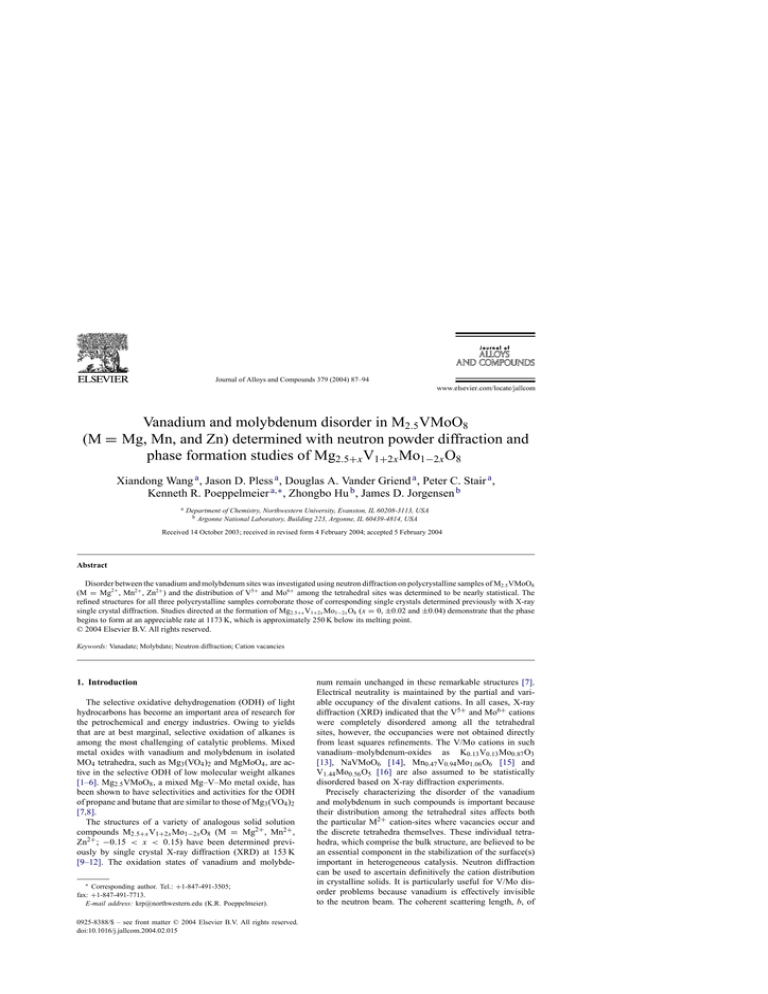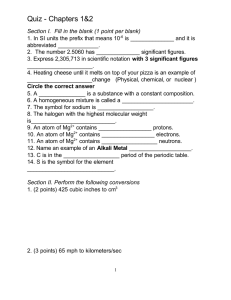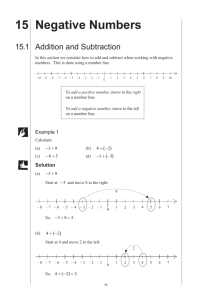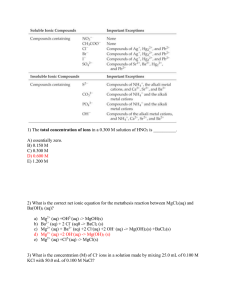
Journal of Alloys and Compounds 379 (2004) 87–94
Vanadium and molybdenum disorder in M2.5VMoO8
(M = Mg, Mn, and Zn) determined with neutron powder diffraction and
phase formation studies of Mg2.5+x V1+2x Mo1−2x O8
Xiandong Wang a , Jason D. Pless a , Douglas A. Vander Griend a , Peter C. Stair a ,
Kenneth R. Poeppelmeier a,∗ , Zhongbo Hu b , James D. Jorgensen b
a
Department of Chemistry, Northwestern University, Evanston, IL 60208-3113, USA
b Argonne National Laboratory, Building 223, Argonne, IL 60439-4814, USA
Received 14 October 2003; received in revised form 4 February 2004; accepted 5 February 2004
Abstract
Disorder between the vanadium and molybdenum sites was investigated using neutron diffraction on polycrystalline samples of M2.5 VMoO8
(M = Mg2+ , Mn2+ , Zn2+ ) and the distribution of V5+ and Mo6+ among the tetrahedral sites was determined to be nearly statistical. The
refined structures for all three polycrystalline samples corroborate those of corresponding single crystals determined previously with X-ray
single crystal diffraction. Studies directed at the formation of Mg2.5+x V1+2x Mo1−2x O8 (x = 0, ±0.02 and ±0.04) demonstrate that the phase
begins to form at an appreciable rate at 1173 K, which is approximately 250 K below its melting point.
© 2004 Elsevier B.V. All rights reserved.
Keywords: Vanadate; Molybdate; Neutron diffraction; Cation vacancies
1. Introduction
The selective oxidative dehydrogenation (ODH) of light
hydrocarbons has become an important area of research for
the petrochemical and energy industries. Owing to yields
that are at best marginal, selective oxidation of alkanes is
among the most challenging of catalytic problems. Mixed
metal oxides with vanadium and molybdenum in isolated
MO4 tetrahedra, such as Mg3 (VO4 )2 and MgMoO4 , are active in the selective ODH of low molecular weight alkanes
[1–6]. Mg2.5 VMoO8 , a mixed Mg–V–Mo metal oxide, has
been shown to have selectivities and activities for the ODH
of propane and butane that are similar to those of Mg3 (VO4 )2
[7,8].
The structures of a variety of analogous solid solution
compounds M2.5+x V1+2x Mo1−2x O8 (M = Mg2+ , Mn2+ ,
Zn2+ ; −0.15 < x < 0.15) have been determined previously by single crystal X-ray diffraction (XRD) at 153 K
[9–12]. The oxidation states of vanadium and molybde∗ Corresponding author. Tel.: +1-847-491-3505;
fax: +1-847-491-7713.
E-mail address: krp@northwestern.edu (K.R. Poeppelmeier).
0925-8388/$ – see front matter © 2004 Elsevier B.V. All rights reserved.
doi:10.1016/j.jallcom.2004.02.015
num remain unchanged in these remarkable structures [7].
Electrical neutrality is maintained by the partial and variable occupancy of the divalent cations. In all cases, X-ray
diffraction (XRD) indicated that the V5+ and Mo6+ cations
were completely disordered among all the tetrahedral
sites, however, the occupancies were not obtained directly
from least squares refinements. The V/Mo cations in such
vanadium–molybdenum-oxides as K0.13 V0.13 Mo0.87 O3
[13], NaVMoO6 [14], Mn0.47 V0.94 Mo1.06 O6 [15] and
V1.44 Mo0.56 O5 [16] are also assumed to be statistically
disordered based on X-ray diffraction experiments.
Precisely characterizing the disorder of the vanadium
and molybdenum in such compounds is important because
their distribution among the tetrahedral sites affects both
the particular M2+ cation-sites where vacancies occur and
the discrete tetrahedra themselves. These individual tetrahedra, which comprise the bulk structure, are believed to be
an essential component in the stabilization of the surface(s)
important in heterogeneous catalysis. Neutron diffraction
can be used to ascertain definitively the cation distribution
in crystalline solids. It is particularly useful for V/Mo disorder problems because vanadium is effectively invisible
to the neutron beam. The coherent scattering length, b, of
88
X. Wang et al. / Journal of Alloys and Compounds 379 (2004) 87–94
vanadium is negative (b(V) = −0.3824(12) fm), while that
for molybdenum is sizably positive (b(Mo) = 6.715(20)
fm) [17]. The investigation of the disorder of V5+ and
Mo6+ in the title oxides with neutron diffraction is reported
here for the first time.
In addition, uncertainty remains in the literature regarding the formation of Mg2.5 VMoO8 and the temperature at
which it forms, although its structure and catalytic properties
have been reported [7,9,18]. López Nieto and co-workers
reported that they were unable to detect the formation of
Mg2.5 VMoO8 in compositions of (mole percentage); 81.7,
4.7 and 13.6% and 87.8, 5.6 and 6.6% of MgO, V2 O5 and
MoO3 , respectively (where all of the MgO was the support phase) [19]. They detected three-phase mixtures of predominately MgO, and lesser amounts of Mg3 (VO4 )2 and
MgMoO4 after the samples were calcined at 1173 K. As a result of the apparent discrepancy reported [19] for the preparation of Mg2.5 VMoO8 , a reinvestigation of the formation
of this compound was undertaken.
2. Experimental
Polycrystalline M2.5 VMoO8 (M = Mg, Mn, Zn) samples
for neutron diffraction studies were prepared by solid state
reaction of MgO (98%, Aldrich), Mn2 O3 (99.9%, Aldrich),
or ZnO (99.99%, Aldrich), with V2 O5 (99.6%, Aldrich)
and MoO3 (>99.5%, Aldrich). Stoichiometric amounts of
the appropriate oxides were ground in an agate mortar and
ball-milled in an agate cylinder for approximately 30 min.
Mg2.5 VMoO8 was prepared by calcination at 903 K for 14 h
in air in an Al2 O3 crucible. The sample was then pressed
into pellets and heated at 1173 K for 172 h and 1353–1373 K
for 40 h in air on platinum foil. Mn2.5 VMoO8 was prepared by calcination at 923 K for 12 h and then 953 K for
24 h. The sample was then ground, ball-milled and pressed
into pellets before heating at 1023 K for 18 h and finally at
1173 K for 46 h in flowing argon. One intermittent grinding,
ball-milling and pelletizing procedure was conducted during
the last heat treatment. The inert atmosphere is necessary
to control the oxidation state of manganese. Zn2.5 VMoO8
was prepared by calcination at 923 K for 24 h in air in an
Al2 O3 boat. The sample was then pressed into a pellet and
heated at 1073–1083 K for 90 h in air with one intermittent
grinding, ball-milling and pelletizing procedure. The temperatures for the different heat treatments of the three samples were chosen to be approximately 35–110 K below their
melting points [9–11]. Powder X-ray diffraction confirmed
that all three samples were single phase.
Powder X-ray diffraction patterns were recorded at room
temperature on a Rigaku diffractometer (Cu K␣ radiation,
Ni filter, 40 kV, 20 mA; 2θ = 10–70◦ , 0.05◦ step size and
1 s count time) and used for crystalline phase identification.
The phases were identified by comparison with the data reported in the Joint Committee of Powder Diffraction Standards (JCPDS) database.
Table 1
Crystallographic data for M2.5 VMoO8
Formula
Formula weight
Crystal system
Space group
a (Å)
b (Å)
c (Å)
Z
dcalc (g/cm3 )
Variables
Rp
Rwp
χ2
Mg2.5 VMoO8
335.64
Orthorhombic
Pnma
5.05355(5)
10.34326(9)
17.4613(2)
6
3.66
55
0.0363
0.0509
5.176
Mn2.5 VMoO8
412.23
Orthorhombic
Pnma
5.16413(5)
10.58043(9)
17.8711(2)
6
4.21
65
0.0308
0.0415
3.031
Zn2.5 VmoO8
438.36
Orthorhombic
P21 21 21
5.04316(6)
10.4054(1)
17.5657(2)
6
4.74
96
0.0311
0.0440
3.645
Powder neutron diffraction experiments were performed
at the intense pulsed neutron source (IPNS) [20] at Argonne
National Laboratory. Room temperature data (293 K) for
all three compounds were recorded on the general purpose
powder diffractometer. Low temperature (250, 150, 50 K)
data for Zn2.5 VMoO8 were recorded on the special environment powder diffractometer. Approximately 1 g of sample
were loaded into cylindrical vanadium cans with sealed ends.
Three pairs of detector banks with a total of 144 detectors,
located at 150, 90 and 60◦ relative to the incident neutron
beam, were used for data collection. The data collection for
each sample required 12 h.
The data were analyzed using General Structure Analysis
Software (GSAS) [21]. The unit cell parameters and atomic
positions obtained from single crystal X-ray studies [9–11]
were used as initial values for the refinements. In the final
cycles of refinement, the unit cell parameters, atomic coordinates, an isotropic temperature factor for each atom as well
as two terms of the Von Dreele–Jorgensen–Windor convolution peak shape function [22] were refined simultaneously
against the intensities of 4196 observations. Only data from
the high resolution back-scattering detector banks at 150◦
were used in the refinements. The crystallographic data and
refined parameters are given in Table 1. The atomic positions
and temperature factors for Mg2.5 VMoO8 , Mn2.5 VMoO8
and Zn2.5 VMoO8 are listed in Tables 2–4, respectively.
Samples of Mg2.5+x V1+2x Mo1−2x O8 (x = 0, ±0.02 and
±0.04) for thermal studies were prepared by a sol–gel
method. The sol–gel method ensures a homogeneous mixture of the precursors, thereby lowering the calcination
temperature generally required to overcome the kinetic
limitations of solid-state diffusion. Stoichiometric amounts
of magnesium ethoxide (Mg 21–22%, Alfa Aesar), vanadium triisopropoxide oxide (95–99%, Alfa Aesar) and
bis(acetylacetonato)dioxomolybdenum(VI) (99%, Aldrich)
were dissolved and refluxed in 2-methoxy ethanol (99%,
Aldrich). The alkoxides were hydrolyzed with a 5% by
volume NH4 OH aqueous solution. Upon hydrolysis, the
samples precipitated from solution. After evaporation of the
solvent, the precursors were dried at 383 K for 12 h. In one
study, each of the five dried samples was calcined for 12 h
X. Wang et al. / Journal of Alloys and Compounds 379 (2004) 87–94
89
Table 2
Atomic parameters for Mg2.5 VMoO8
Atom
Wyckoff
x
y
z
100 × Uiso
Occupancy
V(1)
Mo(1)
V(2)
Mo(2)
Mg(1)
Mg(2)
Mg(3)
O(1)
O(2)
O(3)
O(4)
O(5)
O(6)
O(7)
4c
4c
8d
8d
8d
4c
4c
8d
8d
8d
8d
4c
8d
4c
0.215(1)
0.215(1)
0.7229(8)
0.7229(8)
0.7531(5)
0.906(1)
0.2555(7)
0.9229(4)
0.6534(4)
0.9141(4)
0.4344(4)
0.9368(6)
0.4137(5)
0.1453(7)
0.75
0.75
0.4734(3)
0.4734(3)
0.5754(2)
0.75
0.25
0.3702(2)
0.6134(2)
0.5057(2)
0.3856(2)
0.75
0.8853(2)
0.75
0.4428(2)
0.4428(2)
0.3434(2)
0.3434(2)
0.5278(1)
0.2499(3)
0.3025(2)
0.2861(1)
0.2960(1)
0.4251(1)
0.3721(1)
0.5069(2)
0.4649(1)
0.3477(2)
0.047(0.21)
0.047(0.21)
1.2(2)
1.2(2)
1.13(7)
3.6(1)
2.0(1)
1.68(8)
1.64(8)
1.41(7)
1.23(7)
0.91(9)
0.94(8)
1.2(1)
0.516(9)
0.484(9)
0.492(4)
0.508(4)
1
0.75
1
1
1
1
1
1
1
1
in air starting at 1148 K and the temperature was increased
by 25 K every 12 h until the desired phase began to form.
In a second study, the five dried precursors were calcined
at 1173 K for varying time until the products were initially
detected in the powder diffraction patterns.
Differential thermal analysis (DTA) measurements of the
precursors, which had been dried at 383 K for 12 h, were
made on a TA Instruments DSC 2910 Differential Scanning
Calorimeter with platinum crucibles and alumina powder
reference. The heating profiles consisted of linear ramps of 1,
2, 5 and 10 K min−1 from ambient temperature to 1373 K in
a static air atmosphere. Before the measurements were made,
the instrument was calibrated in the range of 430–1337 K to
ensure accuracy.
3. Results and discussion
The final observed, calculated and difference profiles for
Mg2.5 VMoO8 , Mn2.5 VMoO8 and Zn2.5 VMoO8 are shown
in Figs. 1–3, respectively. The results confirm that all three
polycrystalline M2.5 VMoO8 (M = Mg2+ , Zn2+ , Mn2+ )
samples at 293 K have the same structures as the corresponding single crystals at 153 K [9–11]. The Mg2+ and
Mn2+ compounds are isostructural (Pnma). The bond connectivity in the Zn2+ analogue is identical, but distortions in
the trigonal prismatic cation sites lead to a different space
group (P21 21 21 ). The connectivity common to all three is
illustrated in Fig. 4. All tetrahedral sites are occupied exclusively by either V5+ or Mo6+ . The V/MoO4 tetrahedra link
the trigonal prismatic M2+ O6 and octahedral M2+ O6 sites.
The relatively large thermal displacement factors for Mg(2)
(Table 2), Mn(2) (Table 3) and Zn(1) (Table 4) are a result of
coulombic repulsions between adjacent divalent cations in
the partially occupied (for x = 0 this site is occupied 75%)
linear chains of face-shared octahedra. Many details of the
structures have been described previously [9–11]. Selected
bond distances and angles from the refinement of the neutron data for all three samples are given in Table 5. These
results agree closely with those of the single crystal X-ray
refinements [9–11].
To determine the disorder between vanadium and molybdenum, the relative site occupancies were refined under the
following conditions: (i) the face-shared octahedral sites
Table 3
Atomic parameters for Mn2.5 VMoO8
Atom
Wyckoff
x
y
z
100 × Uiso
Occupancy
V(1)
Mo(1)
V(2)
Mo(2)
Mn(1)
Mn(2)
Mn(3)
O(1)
O(2)
O(3)
O(4)
O(5)
O(6)
O(7)
4c
4c
8d
8d
8d
4c
4c
8d
8d
8d
8d
4c
8d
4c
0.222(1)
0.222(1)
0.7195(7)
0.7195(7)
0.7508(8)
0.909(2)
0.2565(9)
0.9188(5)
0.6550(4)
0.9098(4)
0.4447(4)
0.9446(7)
0.4112(5)
0.1473(7)
0.75
0.75
0.4735(3)
0.4735(3)
0.5782(3)
0.75
0.25
0.3748(2)
0.6093(2)
0.5037(2)
0.3861(2)
0.75
0.8815(2)
0.75
0.4415(3)
0.4415(3)
0.3423(2)
0.3423(2)
0.5278(2)
0.2503(5)
0.3023(3)
0.2873(1)
0.2975(1)
0.4236(1)
0.3706(1)
0.5049(2)
0.4632(1)
0.3509(2)
2.0(2)
2.0(2)
1.2(1)
1.2(1)
2.02(8)
4.6(2)
1.8(1)
2.36(6)
2.57(7)
2.06(6)
2.29(7)
2.14(8)
1.70(7)
2.7(1)
0.47(1)
0.53(1)
0.514(5)
0.486(5)
1
0.75
1
1
1
1
1
1
1
1
90
X. Wang et al. / Journal of Alloys and Compounds 379 (2004) 87–94
Fig. 1. Observed (+), calculated (solid line) and difference (below) neutron diffraction patterns for Mg2.5 VMoO8 . The tic marks indicate the allowed
reflections in Pnma.
(Mg(2), Mn(2) and Zn(1)) were constrained to be 75% occupied, and (ii) all remaining sites were constrained to be
fully occupied. The sum of vanadium and molybdenum is
restrained by the second criteria, but the ratio of the two
elements is not restrained in any way. These constraints
reflect that in order to achieve charge neutrality for the stoichiometry M2.5 VMoO8 there are cation vacancies. These
vacancies are disordered on the Zn(1), Mn(2) and Mg(2)
sites, which form chains of face-shared octahedra, in order
to reduce cation–cation repulsion. However, these vacancies
are likely adjacent to clusters of three occupied sites along
individual chains but lack correlation between chains. In all
three cases, the refined stoichiometry is within 2% of the
nominal formula, which verifies the validity of the refinement model and the constraints used. For Mg2.5 VMoO8 and
Mn2.5 VMoO8 , the refined occupancies of the two crystallographically unique tetrahedral sites are shown in Tables 2
and 3, respectively. The V5+ and Mo6+ cations are almost
completely disordered, in close agreement with the single
crystal studies [9,10] in which the disordered model was
Fig. 2. Observed (+), calculated (solid line) and difference (below) neutron diffraction patterns for Mn2.5 VMoO8 . The tic marks indicate the allowed
reflections in Pnma.
X. Wang et al. / Journal of Alloys and Compounds 379 (2004) 87–94
91
Fig. 3. Observed (+), calculated (solid line) and difference (below) neutron diffraction patterns for Zn2.5 VMoO8 . The tic marks indicate the allowed
reflections in P21 21 21 .
elected based on the Hamilton test [23]. For Zn2.5 VMoO8 ,
there are three unique crystallographic sites, but the occupancies of V5+ and Mo6+ can still be calculated from the
effective site scattering length based on the assumption that
the three tetrahedral sites are fully occupied by some allocation of vanadium and molybdenum. The results are given
in Table 4. V and Mo are essentially disordered on the three
sites. However, V cations show a small preference for the
third site, again in agreement with the X-ray single crystal
study [11]. Refinements of low temperature data (50, 150
and 250 K) with Pnma and P21 21 21 models indicate that the
space group of Zn2.5 VMoO8 remains P21 21 21 between 50
and 293 K.
The formation of Mg2.5+x V1+2x Mo1−x O8 (x = 0)
was examined using powder XRD. Diffraction patterns
of the samples calcined for 12 h at various temperatures
Table 4
Atomic parameters for Zn2.5 VMoO8 a
Atom
Wyckoff
x
y
z
100 × Uiso
Occupancy
V(1)
Mo(1)
V(2)
Mo(2)
V(3)
Mo(3)
Zn(1)
Zn(2)
Zn(3)
Zn(4)
O(1)
O(2)
O(3)
O(4)
O(5)
O(6)
O(7)
O(8)
O(9)
O(10)
O(11)
O(12)
4a
4a
4a
4a
4a
4a
4a
4a
4a
4a
4a
4a
4a
4a
4a
4a
4a
4a
4a
4a
4a
4a
0.215(1)
0.215(1)
0.737(3)
0.737(3)
0.712(3)
0.712(3)
0.408(1)
0.253(1)
0.252(2)
0.754(2)
0.930(2)
0.917(2)
0.433(2)
0.641(2)
0.420(2)
0.1404(9)
0.417(2)
0.9397(8)
0.658(2)
0.918(2)
0.918(2)
0.432(2)
0.740(1)
0.740(1)
0.015(1)
0.015(1)
0.472(1)
0.472(1)
0.751(2)
0.246(1)
0.0698(6)
0.9110(6)
0.1201(7)
0.9798(7)
0.1033(6)
0.8798(7)
0.8769(7)
0.744(1)
0.6090(5)
0.7423(8)
0.6030(7)
0.4925(5)
0.3629(6)
0.3737(6)
0.8082(3)
0.8082(3)
0.9070(8)
0.9070(8)
0.9065(7)
0.9065(7)
0.9995(5)
0.9434(3)
0.7795(4)
0.7227(4)
0.9576(4)
0.8213(4)
0.8736(4)
0.9504(4)
0.7839(5)
0.8997(2)
0.7897(4)
0.7420(2)
0.9564(4)
0.8303(3)
0.9683(4)
0.8830(4)
1.1(1)
1.1(1)
1.1(1)
1.1(1)
1.1(1)
1.1(1)
7.2(2)
2.7(1)
2.1(2)
1.9(2)
2.3(2)
2.6(2)
1.7(2)
1.6(2)
2.6(2)
2.1(1)
0.6(2)
1.9(1)
2.9(3)
1.6(2)
2.1(2)
0.8(2)
0.474(12)
0.526(12)
0.501(17)
0.499(17)
0.552(4)
0.448(4)
0.75
1
1
1
1
1
1
1
1
1
1
1
1
1
1
1
a The unit cell of the zinc analogue is shifted one quarter unit in the z-direction relative to those of the other two structures and the thermal parameters
were constrained to be equal.
92
X. Wang et al. / Journal of Alloys and Compounds 379 (2004) 87–94
Fig. 4. General structure for M2.5 VMoO8 (M = Mg, Mn, Zn). The small
circles marked Mi, M2 and M3 are the V/Mo sites. MO6 polyhedra are
shown as dark grey octahedra and light grey trigonal prisms.
revealed that a mixture of Mg3 (VO4 )2 and MgMoO4 was
present in every sample calcined below 1173 K (Fig. 5).
Mg2.5 VMoO8 (x = 0) was detected at 1173 K. However,
higher reaction temperatures were needed to begin forming
the phases with excess vanadium (x = 0.02, 0.04) or excess
molybdenum (x = −0.02, −0.04). Mg2.5+x V1+2x Mo1−x O8
was detected in all samples by 1223 K. Because many
Mg2.5+x V1+2x Mo1−x O8 samples did not show evidence of
forming at 1173 K after 12 h, a second set of experiments
was conducted to determine if the Mg3 (VO4 )2 and MgMoO4
would react to form a single phase at 1173 K and longer
reaction time. It was found that the Mg2.5 VMoO8 -type
structure begins to form after 24 h of calcination. Single
phase samples for the five compositions (x = 0, ±0.02 and
±0.04) can be obtained by calcining at 1273 K for 24 h.
Investigation of the reaction of the precursors was performed by differential thermal analysis. Fig. 6 shows the
DTA plots of the reactants that form Mg2.5 VMoO8 ; each
scan is offset by 1 K mg−1 for clarification. The observed
features shift to higher temperatures as the heating rates
increase. Three exothermic peaks at approximately 550,
650, and 700 K were detected. These peaks correspond to
the combustion of the organic compounds from the sol–gel
Table 5
Selected bond distances and angles for Mg2.5 VMoO8 , Mn2.5 VMoO8 and Zn2.5 VMoO8
Mg2.5 VMoO8
Distances (Å)
V/Mo(1)−O(5)
V/Mo(1)−O(6)
V/Mo(1)−O(7)
V/Mo(1)−O(8)
V/Mo(2)−O(1)
V/Mo(2)−O(2)
V/Mo(2)−O(3)
V/Mo(2)−O(4)
V/Mo(3)−O(9)
V/Mo(3)−O(10)
V/Mo(3)−O(11)
V/Mo(3)−O(12)
Angles (◦ )
O(5)−V/Mo(1)−O(6)
O(5)−V/Mo(1)−O(7)
O(5)−V/Mo(1)−O(8)
O(6)−V/Mo(1)−O(6)
O(6)−V/Mo(1)−O(7)
O(6)−V/Mo(1)−O(8)
O(7)−V/Mo(1)−O(8)
O(1)−V/Mo(2)−O(2)
O(1)−V/Mo(2)−O(3)
O(1)−V/Mo(2)−O(4)
O(2)−V/Mo(2)−O(3)
O(2)−V/Mo(2)−O(4)
O(3)−V/Mo(2)−O(4)
O(9)−V/Mo(3)−O(10)
O(9)−V/Mo(3)−O(11)
O(9)−V/Mo(3)−O(12)
O(10)−V/Mo(3)−O(11)
O(10)−V/Mo(3)−O(12)
O(11)−V/Mo(3)−O(12)
Mn2.5 VMoO8
1.797(6)
1.764(4) × 2
1.699(6)
1.827(7)
1.744(4) × 2
1.664(6)
1.779(5)
1.704(4)
1.755(5)
1.790(4)
1.766(5)
1.678(4)
1.784(5)
1.768(5)
108.1(2) × 2
116.4(3)
107.6(3) × 2
114.9(4)
105.0(3)
109.4(2) × 2
105.9(4)
110.3(3) × 2
110.7(2)
105.0(2)
108.4(2)
110.3(2)
113.5(2)
108.1(2)
110.9(3)
103.8(2)
108.5(2)
110.2(2)
115.1(2)
107.7(2)
Zn2.5 VMoO8
1.811(13)
1.651(8)
1.733(14)
1.813(8)
1.713(16)
1.800(15)
1.881(15)
1.672(15)
1.643(14)
1.708(14)
1.883(16)
1.792(14)
109.8(8)
103.8(4)
105.9(6)
109.9(7)
116.7(4)
109.9(7)
106.2(5)
108.2(5)
117.7(5)
104.4(5)
110.9(5)
108.5(5)
114.5(5)
106.5(5)
117.8(5)
101.0(5)
111.7(5)
102.9(5)
X. Wang et al. / Journal of Alloys and Compounds 379 (2004) 87–94
93
imately 250 K below its melting point (1423 K) [9]. Others
have reported similar results. For example, the isostructural
zinc compound has been reported by Kurzawa and Boasacka to form at approximately 300 K below its melting point
(1118 K) at 823 K [24,25]. It is not surprising that López
Nieto and co-workers did not detect the formation of the
Mg2.5 VMoO8 structure at 1173 K in their study [19]. Upon
examination of their experimental conditions, it is apparent
that a molybdenum precursor (aqueous ammonium heptamolybdate) was added, by the incipient wetness technique,
to Mg3 (VO4 )2 supported on MgO. Next the samples were
calcined 873 K for 4 h and then at 1173 K for an unspecified
time. Thus, it is probable that their reaction conditions were
at too low of temperature and too short a time to allow the
constituents to diffuse and react.
Fig. 5. Powder diffraction patterns for the metal oxides prepared using the sol–gel technique. The samples were calcined for 12 h at
various temperatures until the Mg2.5 VMoO8 structure was detected:
(a) Mg2.54 V1.08 Mo0.92 O8 —1198 K; (b) Mg2.52 V1.04 Mo0.96 O8 —1198 K;
(c) Mg2.5 VMoO8 —1173 K; (d) Mg2.48 V0.96 Mo1.04 O8 —1198 K; (e)
Mg2.46 V0.92 Mo1.08 O8 —1223 K; (f) 1:2 molar mixture of Mg3 (VO4 )2 (*)
and MgMoO4 (䊊) 1148 K (shown for reference). The diffraction patterns
were taken at ambient temperature in air.
precursors and the formation of a mixture of MgMoO4
and Mg3 (VO4 )2 . The high temperature region (900–1373 K)
shows little information about the reaction. As expected and
discussed in the previous paragraph, Mg2.5 VMoO8 is detected by powder XRD after reaction at 1223 K.
The Mg2.5 VMoO8 (x = 0) structure begins to form at
an appreciable rate at 1173 K. This is consistent with the
phase diagram previously published [9]. Although a variety
of factors can affect the kinetics of a solid-state reaction,
such as the choice of reactants, the homogeneity of the reactants and diffusion, we observe that the phase forms approx-
4. Conclusion
Neutron powder diffraction is an excellent technique to
investigate the disorder between vanadium and molybdenum
in multicomponent vanadomolybdates. The present neutron
study verifies previous X-ray studies on the M2.5 VMoO8
family of compounds and suggests that X-ray studies on
other vanadomolybdates can reliably indicate the site distribution of the high valent cations. Formation studies of
Mg2.5−x V1−2x Mo1+2x O8 (x = 0, ±0.02 and ±0.04) have
shown that these phases do not form at an appreciable rate
below 1173 K and a non-equilibrium mixture of Mg3 (VO4 )2
and MgMoO4 co-exist below this temperature. The high
temperature required for the formation of Mg2.5 VMoO8
combined with results from other studies demonstrates that
the reaction is limited by solid-state diffusion.
Acknowledgements
The authors gratefully acknowledge the National Science Foundation, Solid State Chemistry (Award nos.
DMR-9412971 and DMR-9727516) and from the EMSI
program of the National Science Foundation and at the
Northwestern University Institute for Environmental Catalysis (Grant No. 9810378) for support of this work. The
authors made use of the Central Facilities supported by
the MRSEC program of the National Science Foundation
(Grant DMR-0076097) at the Materials Research Center
of Northwestern University. The work at the Intense Pulse
Neutron Source (IPNS) at Argonne National Lab was supported by DOE W-31-109-ENG-38.
Fig. 6. Differential thermal analysis plots of Mg2.5 VMoO8 . The plots
were offset by 1 K mg−1 for clarity. The heating profiles consisted of: (a)
10 K min−1 ; (b) 5 K min−1 ; (c) 2 K min−1 ; (d) 1 K min−1 . The plots were
taken in air from ambient temperature to 1173 K.
References
[1] F. Cavani, F. Trifiro, Catal. Today 24 (1995) 307–313.
[2] E.A. Mamedov, V. Cortes Corberan, Appl. Catal. A 127 (1995) 1–40.
94
X. Wang et al. / Journal of Alloys and Compounds 379 (2004) 87–94
[3] M.M. Bettahar, G. Costentin, L. Savary, J.C. Lavalley, Appl. Catal.
A 145 (1996) 1–48.
[4] S. Albonetti, F. Cavani, F. Trifiro, Catal. Rev.-Sci. Eng. 38 (1996)
413–438.
[5] T. Blasco, J.M. Lopez Nieto, Appl. Catal. A 157 (1997) 117–142.
[6] H.H. Kung, M.C. Kung, Appl. Catal. A 157 (1997) 105–116.
[7] W.D. Harding, H.H. Kung, V.L. Kozhevnikov, K.R. Poeppelmeier,
J. Catal. 144 (1993) 597–610.
[8] J.D. Pless, D. Ko, R.R. Hammond, B.B. Bardin, P.C. Stair, K.R.
Poeppelmeier, submitted for publication.
[9] X. Wang, C.L. Stern, K.R. Poeppelmeier, J. Alloys Compd. 243
(1996) 51–58.
[10] X. Wang, K.R. Heier, C.L. Stern, K.R. Poeppelmeier, J. Alloys
Compd. 267 (1998) 79–85.
[11] X. Wang, K.R. Heier, C.L. Stern, K.R. Poeppelmeier, J. Alloys
Compd. 255 (1997) 190–194.
[12] X. Wang, D.A. Vander Griend, C.L. Stern, K.R. Poeppelmeier, Inorg.
Chem. 39 (2000) 136–140.
[13] B. Darriet, J. Galy, J. Solid State Chem. 8 (1973) 189–194.
[14] B. Darriet, J. Galy, Bull. Soc. Fr. Miner. Crystallogr. 91 (1968) 325–
331.
[15] R. Kozlowski, K.J. Stadnicka, Solid State Chem. 39 (1981) 271–
276.
[16] L. Kihlborg, Acta Chem. Scand. 21 (1967) 2495–2502.
[17] A.J.C. Wilson, International Tables for Crystallography, vol. C, first
ed., Kluwer Academic Publishers, Dordrecht/Boston/London, 1995.
[18] V.G. Zubkov, I.A. Leonidov, K.R. Poeppelmeier, V.L.J. Kozhevnikov,
Solid State Chem. 111 (1994) 197–201.
[19] A. Dejoz, J.M. Lopez Nieto, F. Marquez, M.I. Vazquez, Appl. Catal.
A 180 (1999) 83–94.
[20] J.D. Jorgensen, J. Faber Jr., J.M. Carpenter, R.K. Crawford, J.R.
Haumann, R.L. Hitterman, R. Kleb, G.E. Ostrowski, F.J. Rotella,
T.G. Worlton, J. Appl. Crystallogr. 22 (1989) 321–333.
[21] A.C. Larson, R.B. Von Dreele, General Structure Analysis System
(GSAS), Los Alamos National Laboratory Report LAUR, 1994.
[22] R.B. Von Dreele, J.D. Jorgensen, C.G. Windsor, J. Appl. Crystallogr.
15 (1982) 581–589.
[23] W.C. Hamilton, Acta Cryst. 18 (1965) 502–510.
[24] M. Kurzawa, M. Bosacka, J. Therm. Anal. Calorim. 64 (2001) 1081–
1085.
[25] P. Tabero, M. Bosacka, M.J. Kurzawa, Therm. Anal. Calorim. 65
(2001) 865–869.







